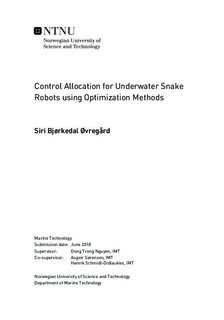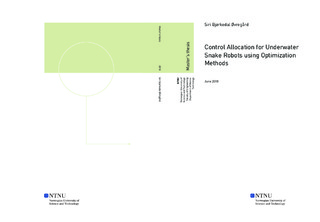| dc.description.abstract | Although the concept of underwater vehicles has existed for a very long time, the technology
within the field has progressed substantially over the recent decades. As more and more oil and
gas installations and operations are performed subsea, the need for more developed underwater
vehicles is still present. A new concept which has the potential to fulfill these demands is the
Underwater Underwater Snake Robot. The fact that the robot is shaped as a snake makes it
ideal for moving in high viscosity environments such as water. In addition, the robot s ability
to alter configuration provides a large workspace, and its slender and articulate body allows the
robot to access narrow spaces. The fact that the underwater snake robot is, itself, a manipulator
arm capable of performing light intervention tasks, makes it a powerful tool.
In this thesis, methods for thrust allocation for underwater snake robots are evaluated. Two
iterative methods, using linear and quadratic programming, are presented, developed and implemented.
This is also done for an explicit method for constrained thrust allocation, using redistributed
pseudo-inverse. The methods are implemented into an existing underwater snake
robot simulation model in Matlab/SIMULINK. Simulations are performed for unconstrained
and constrained thrust allocation, simulating planar and thee-dimensional motion. In the unconstrained
case, simulations are also performed using a pre-implemented standard damped
inverse algorithm. This is done in order to compare thrust allocation algorithm performances.
It is found that all developed algorithms produce satisfactory simulation results, although
some variations in performance is found. The linear programming algorithm produces a small
error between commanded and actual thrust, but tends to favor using a low amount of thrusters,
which is not ideal. In the constrained case, the performance of this algorithm is better.
The redistributed pseudo-inverse algorithm produces a large error compared to the other
methods. The performance is therefore found to be sub-optimal. The quadratic programming
algorithm produces low errors for all simulation cases. The algorithm also tends to distribute
the commanded thrust more evenly amongst the thrusters. This is a significant up-side as it
reduces wear and tear on the thrusters.
Thus, it is concluded that the quadratic programming algorithm for thrust allocation produces
the most satisfactory results, although all thrust allocation methods have proven to be
viable for use on underwater snake robots. | |

